For visitors touring Rainbow Acres, Weaving is one of the favorite stops. With seventeen looms and shelves full of colorful fiber, the room itself offers a warm invitation for resident adults with developmental differences to enter and learn a new skill.
Weaving is a favorite of our residents, as well. Many of our neurodiverse Ranchers sign up for classes or one-on-one sessions with Colleen Murphy, Director of Practical Arts. They learn to weave mug rugs, scarves, and placemats. Those with advanced skills graduate to creative wall hangings and lovely ruanas.
To be successful, the weaving room requires many pairs of hands behind the scenes preparing the looms for the classes. For seventeen years, Jill Suydam has been one such pair of hands. Volunteering on site once or twice a week, she has put in many hours preparing for our Rancher’s weaving classes.
“Jill’s help goes beyond winding warps and setting up looms,” Colleen tells us. “Jill contributes a great deal of knowledge regarding using woven fabric to make finished garments.”
On a cool February morning, we meet Jill in the weaving room for a chat and an impromptu demonstration of all that loom preparation entails.
Backdropped by colorful woven wall hangings, Jill sits on the bench of a one-hundred-year-old wooden loom. Between her feet rests a bag of one hundred and eighty twelve-foot-long individual strands of rug yarn she’s already wound together. Her job is to guide the yarn, combing through it with her fingers to keep it straight, while another volunteer, Patti, slowly turns the back beam, winding the warp strands onto it. They pause every foot or so to layer sheets of paper between the yarn on the beam.
RA: Jill, did you grow up locally, or are you a transplant?
JS: I’m from Detroit, Michigan, where it’s overcast and gray all winter. There for a while, we had an ice storm every New Year’s Eve. It was the running joke that if you were going to have a party, you needed to tell your guests to bring their overnight clothes.
RA: When did you come to Arizona?
JS: We came to Phoenix in ‘72. My ex worked for APS. They transferred us to Farmington, New Mexico, for a year and a half. Then transferred us back.
RA: Did you work as well?
JS: Chemistry teacher. It’s just like teaching cooking.
RA: A little more explosive than cooking.
JS: (laughing) Yes.
RA: Did you grow up enjoying science?
JS: I always had little bottles full of stuff at home. My mother wouldn’t allow me to have a chemistry set. I did get a microscope. That was almost as good.
RA: Weaving appears to require a methodical, scientific approach. Does that speak to you?
JS: Yes. There is a type of Japanese weaving where you go with the flow. Add colors to the weft as you weave. I’m not good at it. I like to plan what I’m going to do.
RA: When did you learn to weave?
JS: In the 70s. What with kids and a job and life in general, I didn’t do as much as I would have liked.
RA: What about weaving do you enjoy?
JS: I enjoy working with wool. I have a cone of dark red silk I want to try. Haven’t yet. I make scarves and ruanas. I belong to the Verde Valley Weavers and Spinners Guild, and we have a sale in Sedona every year. There are usually a lot of people visiting from colder climates, and the scarves sell really well.
RA: Is there a color palette you enjoy working with?
JS: The Sedona Colors.
RA: And do you have your own loom?
JS: Yes. I live in a single wide trailer. My living room is my studio, and I have fiber stored in every nook and cranny. Even my guest bathtub.
RA: How did you end up volunteering here?
JS: Seventeen years ago, when I came to the area, I went looking for a weaver’s guild. [Former volunteer] Mary Pendleton helped found the local guild. She had been in a car accident, and they needed someone to come here, to Rainbow Acres, and help with weaving.
RA: And you have stayed all this time.
JS: I love working with the ranchers. They are a good group. Jack stands out. He’s in his eighties and going strong. He’s very artistic and creative. When he nears the end of his warp, we turn him loose to do what he wants.
RA: Do you work directly with the Ranchers?
JS: If I see something they need help with, yes. My focus is on preparing the looms.
RA: Walk us through that process.
JS: We use rug yarn for the warp. It’s cost-effective and comes in many colors. I will turn on a show on at home and walk around the warping reel, wrapping the warp threads onto it. That is what is in the bag. Then we take the ends and run them through the center of the loom, guiding them through the raddle as we do.
The raddle looks like a strip of wood with small metal pegs. Clusters of long warp yarn have been placed across the raddle between the pegs. Patti sits opposite Jill, winding the yarn onto the back beam, stopping to make sure the strands remain separate between the raddle clusters.
Jill then encourages us to visit a nearby loom where staff member Loretta Hullinger, and volunteer Linda Lundt, are working on the next step of loom preparation—hooking each strand through the heddles. Heddles are thin wires with an eyehole in the middle. They slide up or down when a weaver pushes the pedals.
After pushing the pedal, the artisan will pass the shuttle with the weft yarn through the separated warp yarns. The pedal is pressed again, and the shuttle passed back through in a simple over-under pattern.
RA: How many strands of yarn in the warp?
JS: Depends, sixty to eighty for mug rugs. Two hundred and eighty-eight for ruanas.
RA: Each strand of yarn prepared by hand.
JS: Yes.
Two hundred and eighty-eight lengths of yarn methodically wrapped around the warping reel. Then carefully wound onto the back beam. Each one individually hooked through the heddles, then fastened onto the reed.
A great deal of yarn and a great deal of time!
Without pairs of hands willing to take part in this intense behind-the-scenes preparation of the looms, our weaving program would not be what it is — a great place for our Ranchers, even those with physical limitations, to gain skills and confidence. Once a Rancher has learned the basics, the process is very relaxing and a wonderful opportunity for their inner artisan to emerge.
We are beyond grateful to Jill for her many years of service, and for the other volunteers who help us weave a life of purpose for our Ranchers.

